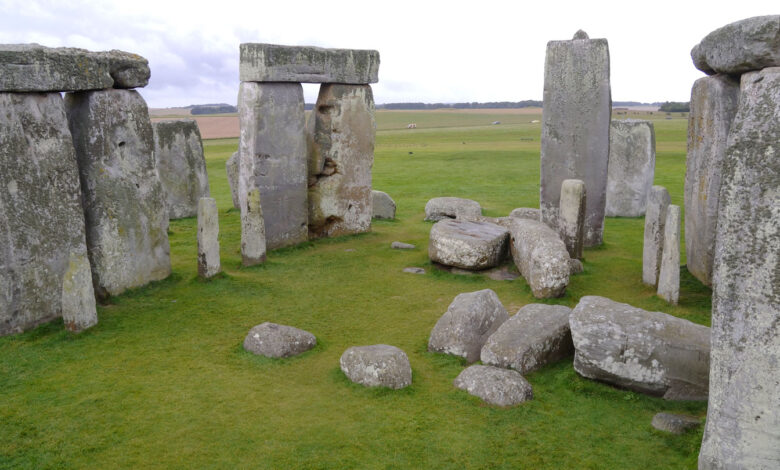Archaeology’s top discoveries of 2024 include preserved brains and a lost city

Grizzly details about ancient child sacrifices, a map of a lost city in the Amazon and the answer to a Stonehenge mystery are some of this year’s insights into human history.
Bygone brains
Discovering a human brain at an archaeological site is more common than you might think. A new archive catalogs some 4,400 ancient brains that have been found dried out, frozen or otherwise preserved (SN: 3/19/24). Brains may owe such surprising sturdiness to their chemical makeup.

Ancient arts and crafts
The oldest rock art in the Americas may be a set of cave paintings in Argentina that date back some 8,200 years (SN: 3/9/24, p. 16). That’s several thousand years older than other rock art in the region. The nearly 900 paintings in a cave called Cueva Huenul 1 — which include geometric shapes plus figures of humans and animals — may have helped preserve cultural knowledge across generations of hunter-gatherers.

Herder heritage
Yamnaya herders arriving from southwest Asia rewrote Europe’s genetic history starting around 5,000 years ago, according to the DNA of more than 1,600 ancient people (SN: 2/10/24, p. 14). Northern Europeans may have Yamnaya ancestry to thank for their taller statures and lighter skin, as well as their vulnerability to multiple sclerosis. Eastern Europeans, meanwhile, may have inherited a Yamnaya gene variant linked to Alzheimer’s disease.

Egyptian ergonomics
Hunching over scrolls took a toll on ancient Egyptian scribes (SN: 6/27/24). The skeletons of 30 scribes buried at the Abusir pyramid complex show signs of arthritis and other damage from poor posture.

Stonehenge’s Scottish centerpiece
The mysterious Altar Stone at the heart of Stonehenge likely came from Scotland (SN: 8/14/24). Previously thought to share the Welsh origins of other Stonehenge blocks, the stone closely matches the mineral makeup of the Orcadian Basin, a Scottish rock formation.

Pompeii’s terrible, horrible, no good, very bad day
Pompeii’s infamous apocalypse was worse than thought. When Mount Vesuvius erupted in A.D. 79, it didn’t just coat nearby cities with lethally hot gas, ash and rock — it also triggered deadly earthquakes, a study of collapsed buildings and crushed skeletons found (SN: 8/7/24).

Maya sacrifices unmasked
Child sacrifices in a Maya burial chamber on the Yucatán Peninsula were all young boys, DNA shows, upending a theory that women were sacrificed there in fertility rituals (SN: 6/12/24). The boys, sacrificed between A.D. 500 and 900, may have been killed to appease a rain god.

A lost city no more
Laser scans unveiled the earliest and largest known urban complex in the Amazon (SN: 1/11/24). Beneath the trees in Ecuador’s Upano Valley lie thousands of mounds that were once homes and community spaces, along with remnants of roads and farms. Inhabited from roughly 500 B.C. to A.D. 1500, the city shows how sophisticated Amazonian civilizations were long before European conquest.

X marks the spot
In a rare case of productive social media scrolling, a researcher identified part of a lost civilization’s alphabet in a photo of an engraved slate posted to X (SN: 6/24/24). Found in Spain, the slate is from the Tartessos civilization, which vanished in the fifth century B.C. The writing system is linked to the Phoenician alphabet that shaped Latin, Spanish and English writing.

Agriculture was not inevitable
A group of Stone Age hunter-gatherers known as the Iberomaurusians ate a mostly vegetarian diet of wild plants for millennia. And they did that without ever growing those plants as crops, according to an analysis of roughly 15,000-year-old human bones and teeth from a cave in Morocco (SN: 6/1/24, p. 14). These findings challenge the traditional idea that plant-based diets ultimately lead humans to grow their own food.

Population boom idea is a bust
Contrary to popular belief, early Polynesian settlers of Rapa Nui, aka Easter Island, might not have undergone a population boom that destroyed their civilization and the island’s environment. Ground surveys and satellite data hint that Polynesian islanders who arrived some 800 years ago set up a modest farming system and maintained a steady population of less than 4,000 until Europeans arrived 300 years ago (SN: 8/10/24, p. 14).




